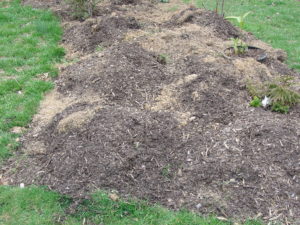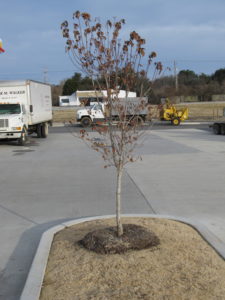Adding large amounts of compost or organic matter to a planting hole greatly improve the soil’s water-holding capacity and aeration. Simply throwing piles of leaves into the bottom of the planting hole helps improve a soil. However, amending the planting hole is not recommended by most plant experts. Why? According to soil scientists, the plant roots stay locked within the rich planting media in planting hole, like a pot, and roots don’t grow out into the surrounding native soil. This is especially true in heavy clay soils.
Doing it right: A wide shallow hole is more correct and a lot easier that one that’s narrow and very deep. Thoroughly mix organic amendments with the surrounding soil into the planting hole. Use a rototiller or 4-tine fork to turn and thoroughly mix humus, leaf litter, or compost into the planting hole.
Adding organic matter has good properties to improve the soil’s water- and nutrient-holding capacity. Humus rich soils are more porous and alive with beneficial organisms such as earth worms and beneficial fungi. However, too much is no good either. The ingredients peat, bark, and coarse sand make the backfill.
Finally, get the tree depth in the hole correct. Placing a heavy tree or shrub in the planting hole will compress the loose fill, often resulting in a tree being planted too deep.
Extra facts: Acidic organic materials are valuable to acid-loving shrubs such as rhododendrons, azaleas, mountain laurels, blueberries. Acidifying fertilizers, such as ammonium nitrate, ammonium sulfate, and sulfur-coated urea can also raise soil acidity levels. Mulch acid-loving plants with acidic materials such as pine needles, bark, and nuggets, and oak leaves; all eventually decompose into humus.
Organic mulches also cool roots of tree and shrub species, particularly in warmer climes Native trees, such as Beech (Fagus grandifolia)), paper , gray, and river birches (Betula spp.), sourwood (Oxydendrum), black gum (Nyssa sylvatica), silverbell (Halesia) and dogwoods (Cornus spp.).



 Posted in
Posted in 
